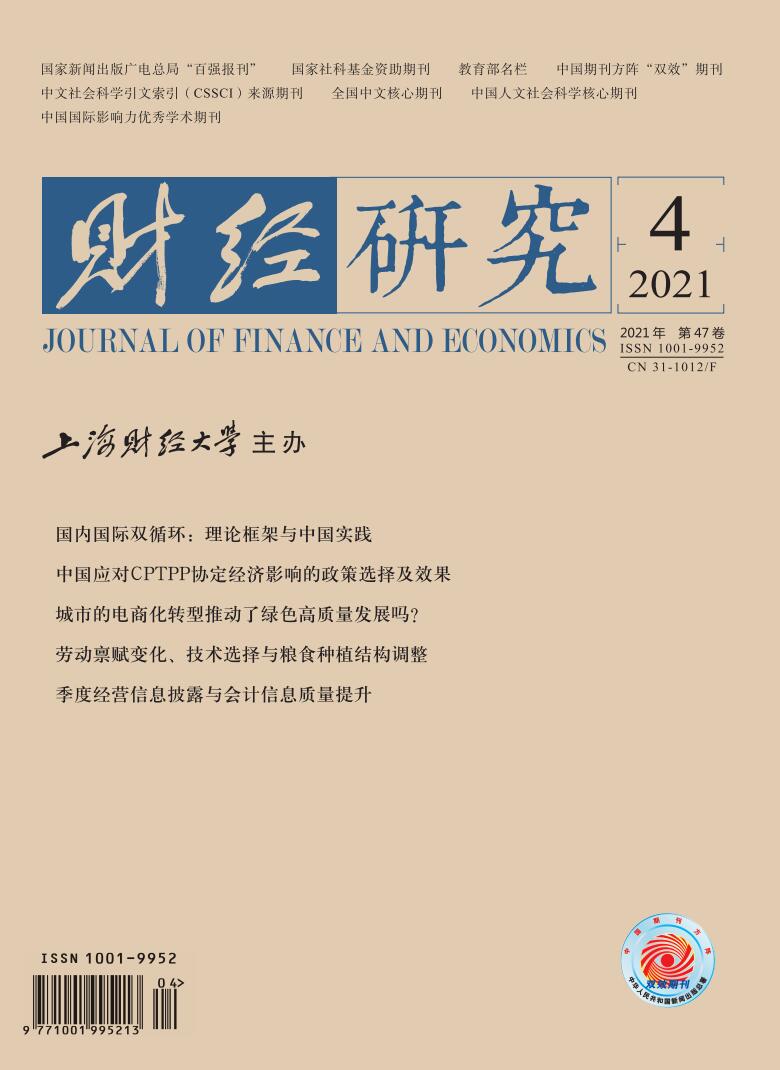地方隐性债务的无序扩张会削弱中国经济的长期发展动能。面对隐性债务规模的不断膨胀和企业研发活动增速的下降,很多经济观察者产生了这样的疑问,过高的地方债务水平是否会抑制微观企业的创新? 这一影响的潜在作用机制是什么?文章基于2008年至2017年非金融业上市公司数据和手工搜集的地方政府隐性债务数据,考察地方政府隐性债务水平对微观企业研发活动的影响。实证结果显示,较高的城市隐性债务水平抑制了当地企业的专利申请数量,但对研发投入的影响不确定,这表明隐性债务水平降低了企业的创新效率。机制分析显示,政府(研发)补贴和长期外部信贷的减少是 “抑制作用”产生的潜在机制。最后,文章还对实证结果进行了异质性分析和稳健性检验。文章的研究对深入理解地方政府隐性债务对实体经济的影响具有一定现实意义。
地方政府隐性债务与企业研发——来自中国非金融上市公司的证据
摘要
参考文献
14 Aghion P,Askenazy P,Berman N,et al. Credit constraints and the cyclicality of R&D investment:Evidence from France[J]. Journal of the European Economic Association,2012,10(5): 1001−1024. DOI:10.1111/j.1542-4774.2012.01093.x
15 Akcigit U, Grigsby J, Nicholas T, et al. Taxation and Innovation in the 20th Century[R]. NBER Working Paper No.24982, 2018.
16 Almeida H,Campello M,Weisbach M S. The cash flow sensitivity of cash[J]. The Journal of Finance,2004,59(4): 1777−1804. DOI:10.1111/j.1540-6261.2004.00679.x
17 Bai C E, Hsieh C T, Song Z M. The long shadow of a fiscal expansion[R]. NBER Working Paper No.22801, 2016.
18 Boeing P,Mueller E,Sandner P. China’s R&D explosion:Analyzing productivity effects across ownership types and over time[J]. Research Policy,2016,45(1): 159−176. DOI:10.1016/j.respol.2015.07.008
19 Chen Z,He Z G,Liu C. The financing of local government in China:Stimulus loan wanes and shadow banking waxes[J]. Journal of Financial Economics,2020,137(1): 42−71. DOI:10.1016/j.jfineco.2019.07.009
20 Croce M M,Nguyen T T,Raymond S,et al. Government debt and the returns to innovation[J]. Journal of Financial Economics,2019,132(3): 205−225. DOI:10.1016/j.jfineco.2018.11.010
22 Fan J P H,Titman S,Twite G. An international comparison of capital structure and debt maturity choices[J]. Journal of Financial and Quantitative Analysis,2012,47(1): 23−56. DOI:10.1017/S0022109011000597
23 Fang L H,Lerner J,Wu C P. Intellectual property rights protection ownership and innovation:Evidence from China[J]. The Review of Financial Studies,2017,30(7): 2446−2477. DOI:10.1093/rfs/hhx023
24 Graham J R,Leary M T,Roberts M R. A century of capital structure:The leveraging of corporate America[J]. Journal of Financial Economics,2015,118(3): 658−683. DOI:10.1016/j.jfineco.2014.08.005
25 Graham J R, Leary M T, Roberts M R. How does government borrowing affect corporate financing and investment? [R]. NBER Working Paper No.20581, 2014.
26 Greenwood R,Hanson S,Stein J C. A gap-filling theory of corporate debt maturity choice[J]. The Journal of Finance,2010,65(3): 993−1028. DOI:10.1111/j.1540-6261.2010.01559.x
27 Hsu P H,Tian X,Xu Y. Financial development and innovation:Cross-country evidence[J]. Journal of Financial Economics,2014,112(1): 116−135. DOI:10.1016/j.jfineco.2013.12.002
28 Huang Y,Pagano M,Panizza U. Local crowding-out in China[J]. The Journal of Finance,2020,75(6): 2855−2898. DOI:10.1111/jofi.12966
29 Liang Y S,Shi K Wang L S,et al. Local government debt and firm leverage:Evidence from China[J]. Asian Economic Policy Review,2017,12(2): 210−232. DOI:10.1111/aepr.12176
30 Mukherjee A,Singh M,Žaldokas A. Do corporate taxes hinder innovation?[J]. Journal of Financial Economics,2017,124(1): 195−221. DOI:10.1016/j.jfineco.2017.01.004
31 Reinhart C M,Rogoff K S. Growth in a time of debt[J]. American Economic Review,2010,100(2): 573−578. DOI:10.1257/aer.100.2.573
引用本文
张路, 尹志超, 王姝勋. 地方政府隐性债务与企业研发——来自中国非金融上市公司的证据[J]. 财经研究, 2021, 47(4): 94-107.
导出参考文献,格式为:






 5659
5659  5261
5261

